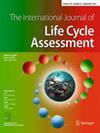Life cycle assessment of a two-seater all-electric aircraft
IF 5.4
3区 环境科学与生态学
Q2 ENGINEERING, ENVIRONMENTAL
引用次数: 0
Abstract
Abstract Purpose Aviation is an important contributor to climate change and other environmental problems. Electrification is one option for reducing the environmental impacts of aviation. The aim of this study is to provide the first life cycle assessment (LCA) results representing an existing commercial, two-seater, all-electric aircraft. Methods An attributional cradle-to-grave LCA was conducted with a functional unit of 1 h flight time. Data and records from an aircraft manufacturer informed much of the study. Detailed modelling of important aircraft components is provided, including the battery, motor, inverter, instrument panel and seats. Impact results are compared to those from a similar but fossil fuel–based two-seater aircraft. A wide range of impact categories was considered, while the focus was on global warming, resource depletion, particulate matter, acidification and ozone formation. Results and discussion The main contributors to almost all impact categories are the airframe, the lithium-ion battery and emissions (in the use phase). The airframe has a major impact as it contains energy-intensive, carbon fibre–reinforced composites, the impact of which can be reduced by recycling. The battery dominates mineral resource depletion categories and contributes notably to emission-based categories. Producing batteries using non-fossil energy or shifting to less resource-intensive, next-generation batteries would reduce their impact. Use-phase impacts can be reduced by sourcing non-fossil electricity. Despite the need for multiple battery pack replacements, the comparison with the fossil fuel option (based on equal lifetimes) still showed the electric aircraft contributing less to global warming, even in a high-carbon electricity scenario. By contrast, when it concerned mineral resources, the electric aircraft had greater impact than the fossil fuel based one. Conclusions A sufficiently long lifetime is key to bringing the all-electric aircraft’s environmental impacts (such as global warming) below those of fossil fuel–based aircraft. The high burden of the airframe and batteries can then be outweighed by the benefit of more efficient and emission-free electric propulsion. However, this comes with a trade-off in terms of increased mineral resource use.双座全电动飞机的生命周期评估
航空是造成气候变化和其他环境问题的重要因素。电气化是减少航空对环境影响的一种选择。本研究的目的是提供现有商用双座全电动飞机的首个生命周期评估(LCA)结果。方法以1 h飞行时间为功能单位,进行归因性从摇篮到坟墓的LCA。来自一家飞机制造商的数据和记录为这项研究提供了大量信息。提供了重要飞机部件的详细建模,包括电池,电机,逆变器,仪表板和座椅。撞击结果与使用化石燃料的类似双座飞机的撞击结果进行了比较。审议了范围广泛的影响类别,重点是全球变暖、资源耗竭、微粒物质、酸化和臭氧形成。几乎所有影响类别的主要贡献者是机身,锂离子电池和排放(在使用阶段)。机身有一个主要的影响,因为它包含能源密集型,碳纤维增强复合材料,其影响可以通过回收来减少。电池在矿物资源耗竭类别中占主导地位,并对基于排放的类别作出显著贡献。使用非化石能源生产电池或转向资源密集度较低的下一代电池将减少它们的影响。使用阶段的影响可以通过采购非化石电力来减少。尽管需要更换多个电池组,但与化石燃料选择(基于相同的使用寿命)的比较仍然表明,即使在高碳电力情景下,电动飞机对全球变暖的贡献也较小。相比之下,当涉及到矿产资源时,电动飞机比基于化石燃料的飞机影响更大。足够长的寿命是使全电动飞机的环境影响(如全球变暖)低于化石燃料飞机的关键。这样一来,更高效、无排放的电力推进系统所带来的好处就能抵消机身和电池的沉重负担。然而,这在增加矿物资源使用方面是有代价的。
本文章由计算机程序翻译,如有差异,请以英文原文为准。
求助全文
约1分钟内获得全文
求助全文
来源期刊
CiteScore
10.60
自引率
10.40%
发文量
100
审稿时长
8-16 weeks
期刊介绍:
The International Journal of Life Cycle Assessment (Int J Life Cycle Assess) is the first journal devoted entirely to Life Cycle Assessment and closely related methods. LCA has become a recognized instrument to assess the ecological burdens and impacts throughout the consecutive and interlinked stages of a product system, from raw material acquisition or generation from natural resources, through production and use to final disposal. The Int J Life Cycle Assess is a forum for scientists developing LCA and LCM (Life Cycle Management); LCA and LCM practitioners; managers concerned with environmental aspects of products; governmental environmental agencies responsible for product quality; scientific and industrial societies involved in LCA development, and ecological institutions and bodies.

 求助内容:
求助内容: 应助结果提醒方式:
应助结果提醒方式:


